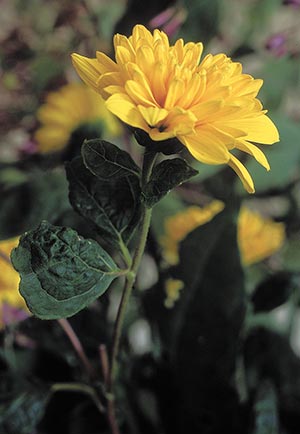
by Janet Macunovich /
Photos by Steven Nikkila
Next year. Perhaps the two most important and versatile words in gardening. They serve as battle cry, mantra, salute, farewell, promise, threat, review, vision and more. Are you using them now as you decide how to spend this long, gentle fall season? You should!
In nature’s cyclical way, fall is not only a wind-down of one season but a start-up of the next. Spring’s growth and summer’s vigor will be based in large part on how much energy plants stored the preceding fall. Soil nutrients accumulate in autumn, dropping in leafy form as coins into a bank. Plant damage that made us grind our teeth this summer are nestling into hideaway holes, ready to retake the garden when warmth returns.
Did you battle an insect or disease this year? Then don’t waste “next year” as a wistful sigh—make it an avenging war whoop by learning what those pests were, where they hide and how to head them off at the pass to ensure a healthy garden next year. Here’s what I’ve learned to do now or sometime before spring about leafhoppers, iris borers and peony botrytis.
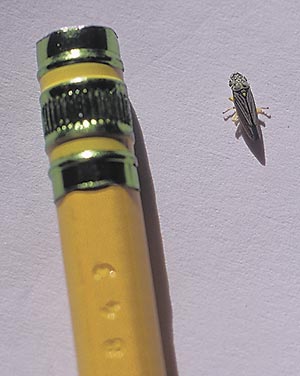
Legions of leafhoppers
Leafhoppers, like most insect populations, go through periods of boom and bust. During the boom, sage, globe thistle, sunflowers, coneflowers, roses, privets, peashrubs, and other plants have stunted growth and stippled foliage or leaf edges that look drained of color and then yellowed in a pattern called “hopperburn.”
The damage isn’t terminal, just unsightly. It doesn’t stop established plants’ bloom. Newer plants are more affected, their energy levels perhaps so reduced that the year is a wash, so they emerge their second spring no larger than when first planted. The biggest trouble with leafhoppers is that some transmit plant viruses. Cross-infection is always possible in a garden, but where leafhoppers flourish the chances of it happening are much higher.
Leafhoppers don’t chew, but insert straw-like mouths into a leaf and suck. If we’re on the lookout, the first pale leaves and distorted new growth are evident in May. By late June, two or more hopper generations later, pale dots on the foliage or yellow halos along leaf edges may be evident from ten paces. At midsummer, even someone unfamiliar with the symptoms can’t miss the nymphs (immature leafhoppers) which spring in all directions when disturbed, like tiny gymnasts in pale green tights launched up and out off trampolines.
If you approach quietly, leafhopper nymphs are simple to kill with any insecticide, even soapy water. Keep two things in mind in choosing that course, though. First, don’t drop your guard—as many as five generations of leafhoppers can occur each year, depending on hopper species and weather. So the plants will probably host the insects again when eggs are laid by hoppers from plants nearby. Second, damage already done is irreversible. Leaves won’t return to full size or the correct shade of green.
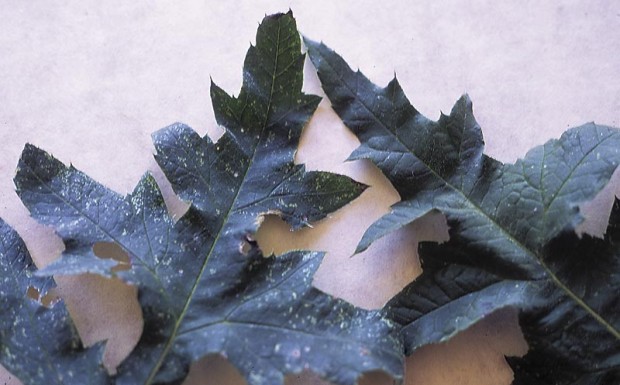
Learn first, spray later
There are many leafhopper species. Some live on myriad unrelated plants while others are restricted to one genus or family—the aster leafhopper pesters aster relatives such as daisies, sunflowers, and coneflowers. Even entomologists have trouble telling leafhopper species apart as nymphs—the most damaging stage—so we group them and deal with them based on what they eat.
Those that feed primarily on woody plants overwinter as eggs on the host plants. The last generation of maple leafhopper adults, for instance, makes slits and lays eggs in maple twigs. Redbanded leafhopper, a pea-green critter with two magenta racing stripes along each flank, makes egg-laying slits in the leaves of the rhododendron, rose, privet, or any of about 50 other species it inhabits. On these woody plants, we can spray egg-smothering dormant oil on the bark, twigs and/or evergreen leaves of the host plants just before spring budbreak.
Hoppers that feed primarily on herbaceous plants lay eggs on those leaves and stalks. Next year’s first generation can be reduced by cutting down stems and removing leaf debris from affected herbaceous plants. No sense removing neighboring, unaffected debris—a leafhopper prefers to lay eggs on the plant on which it fed. Besides, every bit of plant debris is almost as likely to have beneficial insects’ overwintering eggs or pupae—don’t remove it unless you really have to.
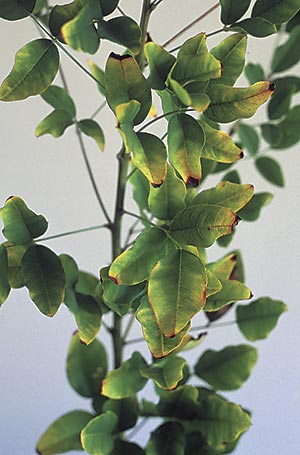
Beware generalities
The more I learn, the more I know that generalities such as “clean up and remove all foliage to reduce pest problems” can cause more work and problems than they solve. For instance, I won’t remove bush clover and peashrub foliage that was hopper-burned this year, or spray them with oil next spring. That’s because it’s very likely those insects were potato leafhopper, a species that can’t overwinter here. It wafts in as an adult from the Gulf of Mexico. No kidding. Why waste time spraying horticultural oil or reduce soil nutrients by raking up egg-harboring leaves when I know the eggs will die and high-altitude winds from Louisiana may not be so buggy next year? I’ll let winter cold do its work, let overwintering ladybugs, lacewings and other beneficials live, and keep an eye peeled for any new windborne infestation next Memorial Day.
Iris foliage and peony foliage are another matter. These are so likely to be attacked by iris borer and peony botrytis each year that clean-up is mandatory. That, or grow them only until the pests build up, then stop growing them for a few years until the pests starve out.
Rx for rotted iris
Irises are laid waste by soft rot, a fungus that spots the foliage and turns the root-like rhizome into malodorous mush. The fungus is too weak to infect whole tissue but gets into leaves and rhizomes through holes made by a moth larva we call iris borer. Bearded irises are particularly vulnerable to soft rot. Siberian irises and others are resistant—they usually don’t rot even when riddled by borers.
To control soft rot, control borers. That means learning the moth’s life cycle.
Small, brown, night-flying iris borer moths lay eggs on iris foliage—especially dead foliage – from late August through October. The eggs hatch in April or May and tiny larvae crawl to emerging iris leaves. They chew into the tight folds of an iris leaf then eat down into the rhizome, growing all the while. By the time they are in the rhizome in July they’re as big as macaroni noodles. From the rhizome they move into the soil, pupate, and emerge in fall as moths.
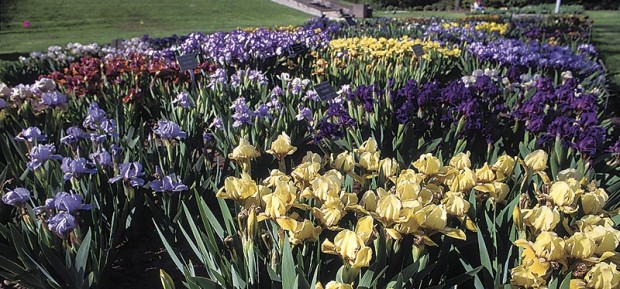

So we remove and burn, compost or bury at least 12 inches deep all iris foliage after egg-laying stops in November. As extra protection in spring, we can spray irises as leaves emerge and every so often–depending on which insecticide is used—until flower buds are well developed. Cygon, a systemic insecticide with a long-lasting effect, can be applied just once or twice, but insecticidal soap must be applied every few days and renewed after rains. Every two or three years we dig up the irises in July when iris borer grubs are in the rhizome, discard rotted or borer-infested rhizomes, and replant clean ones.
Clearing up splotchy peonies
Peonies suffer from peony botrytis, another weak fungus that can’t penetrate healthy tissue but can infect and fester in weak, damaged or dead parts. Purple-brown splotches on foliage, purplish streaks on stems, and hollow, brown-interior stalks are showing the symptoms of peony botrytis.
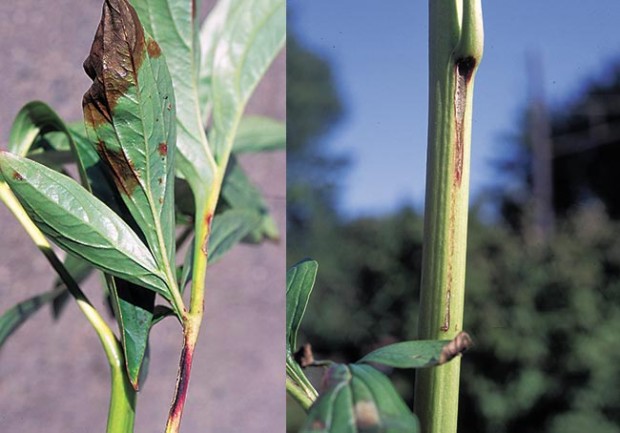
Peony botrytis can splash from disease-laden debris to infect and kill frost-damaged flower buds early in spring—before we even recognize them as buds. The infection lingers there, splashing around and getting new toeholds in weak spots on leaves and stems damaged by wind or insects. The degree of infection increases over years until the plant is too weak to bloom or is a splotchy mess by midsummer. Infected roots harbor shoot-infecting disease spores even below ground and are often too weak to support the stems.
Remove and burn or put peony foliage into a hot compost—if stems are hollow and brown where you cut, cut further down until you see solid white pith. If the infection goes below ground, dig and divide that peony, replanting only solid, uninfected roots. A copper-based fungicide such as Bordeaux mix can be applied in spring as the shoots emerge and weekly until they’re about a foot tall, but removing diseased debris is more important.
Sometimes it’s depressing to know that next year’s problems are already lurking, but only in the narrow view. In the broader view, it’s clear that only a few of the many plant species we grow have significant problems in any given year. We also see there are many living things attached to each plant—perhaps 30 different organisms overwinter on each plant. Many are next year’s “good guys,” so I limit fall garden-scouring to areas of known trouble and let the blessed unknown on other plants rest undisturbed.
Janet Macunovich is a professional gardener and author of the books “Designing Your Gardens and Landscape” and “Caring for Perennials.” Read more from Janet on her website www.gardenatoz.com.

Colleen Hilzinger says
Wonderful. Great info and writing….
jhofley says
Thanks for reading, Colleen!